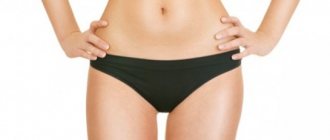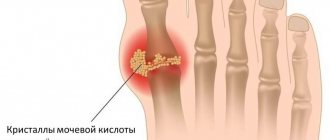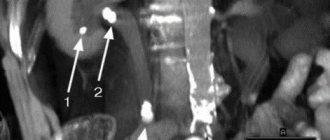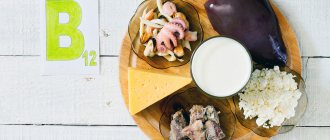Gout is a disease consisting of a disorder of uric acid metabolism.
Gout is usually classified as a joint disease because excess uric acid forms salts (urates), which are deposited primarily in the joints. The first joint affected is the joint of the big toe. An inflamed bump on the thumb is a characteristic symptom of gout. Genetically, men are more predisposed to this disease. Among the sick, almost 95% of them are. The peak incidence in men occurs at the age of 40-50 years, in women – from 60 years and older. However, gout can also affect people at a younger age.
Causes of gout
Any product of biological origin contains purines - substances that are building materials for RNA and DNA. Purine bases ingested in food are broken down, resulting in the formation of uric acid. This is a normal process. Uric acid is present in body tissues and blood plasma. The blood carries uric acid to the kidneys, where it is filtered and excreted in urine. Part of the uric acid (1/3) is excreted through the intestines. If this normal metabolism is disrupted, uric acid begins to accumulate in excess amounts.
Violations of purine metabolism can be caused by:
- genetically determined fermentopathy
. Gout develops if the production of enzymes responsible for converting purine bases into uric acid and removing the latter from the body deviates from the norm (deficiency of some enzymes is critical, hyperfunction of others). This disorder is largely due to DNA damage. The site responsible for these enzymes is located on the X chromosome. Men have one X chromosome, and women have two. This is why men are more likely to suffer from gout (women have, so to speak, a “backup copy” of the necessary genes);
- increased consumption of purine bases
. In ancient times, gout was called the “disease of kings.” The kings ate the best food, and could eat the meat of young animals, deli meats and cream pies unlimitedly (and these products are leaders in purine content. There are also a lot of purines in fatty fish, meat and fish broths, and legumes). In itself, an excess of purines in food is not dangerous, since normally the kidneys cope with the entire volume of uric acid produced. However, if there is a genetic pathology or kidney problems, gout becomes very likely;
- violation of the excretion of uric acid from the body
. If you have kidney disease, uric acid filtration may decrease. Less of it will be excreted, and its concentration in the blood will increase;
- increased catabolism of the body's own purine compounds
. Man is part of the biological world, and our body is built according to general laws. RNA and DNA are present in our body - in every cell, which means they have their own purine bases. Increased cell destruction (or otherwise catabolism - the breakdown of complex compounds into simpler ones) leads to the same increase in uric acid in the blood as if we began to receive an excess amount of purines from the outside. The reasons for the increased catabolism of purine compounds in one's own body may be radiotherapy or chemotherapy, taking certain medications, hemolysis (decomposition of red blood cells, which is caused by severe infectious diseases or diseases of the hematopoietic system).
Watch for deviations!
An increased level of uric acid (UA) in the patient’s blood indicates that we are dealing with a person who already has gout, or the risk of its occurrence is very high. But you should not think that a level of uric acid close to zero completely eliminates this risk. It should be remembered that this indicator is unstable; a single determination of it when obtaining the norm does not allow one to completely reject the diagnosis.
Based on the above, we advise patients to periodically check the level of uric acid in the blood and, if there are abnormalities, consult with a rheumatologist, without waiting for the development of gout and other conditions associated with hyperuricemia. No need to wait 4.5 years. You would rather spend them on something else, but in a healthy state.
Be healthy and complain to doctors about everything that is not the same as yesterday!
Gout symptoms
The first stage of gout is described as hyperuricemia (increased uric acid in the blood).
Hyperuricemia is detected using a biochemical blood test. In most cases, no other symptoms of the disease are detected. Sometimes general weakness, sweating, itchy skin, and constipation may occur. Actually, it is worth talking about gout from the moment of the onset of acute gout attacks. An attack of gouty arthritis can be triggered by:
- drinking alcohol (single consumption of a significant dose);
- hypothermia;
- joint injury;
- common acute respiratory infections.
First of all, as a rule, the joint of the big toe (first metatarsophalangeal joint) is affected. Typically the joint is affected in only one leg. Quite often other small joints are affected - the wrist or phalanges of the fingers. In the future, other joints may suffer from gout attacks. In women, the disease can affect several joints at once at the very beginning.
Typically, an attack of gouty arthritis lasts no more than 5-7 days, after which complete remission occurs (all symptoms disappear) - until the next attack. This course of gout is called the intermittent (“interval”) stage. Then the disease can progress to the chronic stage.
Attack of gouty arthritis
An attack of gouty arthritis is manifested by acute pain in the joint. Quite quickly, the area of the affected joint swells and turns red. The color of the skin over the joint may take on a bluish tint. The patient feels chills and the temperature rises, possibly up to 38 °C or higher. Any touch to the joint increases the pain, the joint completely loses mobility. The pain can be very intense and cannot be relieved by analgesics.
In most cases, the attack occurs at night; by morning the pain usually subsides. However, in severe cases, severe pain can last up to 3 days, then its intensity slowly decreases.
Chronic gout
If attacks of gouty arthritis become frequent and are quite severe (periods of pain prevail over periods of remission), chronic gout is diagnosed. The chronic form of the disease is characterized by increased dysfunction of the affected joints, and as the patient stops using them, atrophy of the articular muscles develops.
A specific symptom of gout is the formation of tophi. Tophus is a subcutaneous or intradermal accumulation of urates (uric acid salts). Tophi look like nodules - dense, rounded formations. Their diameter can vary from 2 mm to 5 cm or more. Tophi usually appear approximately 5 years after the first attack of gout, slowly increasing in size. However, with an unfavorable course, their formation can occur more quickly. Typical places where they occur are fingers and toes, ears, knee and elbow joints, feet, and brow ridges. It doesn't hurt to touch these formations. The skin over tophi is usually dry and rough because its blood supply is impaired. Over time, a fistula may form in this place, through which a white pasty mass (urate itself) is released.
Tophi are not always formed (only in 50-60% of patients).
Chronic gout also often causes urolithiasis. Urates can form kidney stones, which can cause renal colic, block the outflow of urine, and contribute to the development of pyelonephritis.
Risk group for gouty arthritis
Gout is a disease with severe comorbidity, i.e., it often accompanies other chronic diseases, such as type II diabetes mellitus, arterial hypertension and other cardiovascular pathologies, Gierke's disease, and chronic renal failure. When deciding how to treat gouty arthritis, these pathologies cannot be left without treatment. In addition to the factors mentioned, an increased risk of gouty arthritis creates:
- excessive consumption of foods containing purines, chemical precursors of uric acid;
- antitumor therapy;
- the presence of autoimmune diseases and problems with the genitourinary system;
- alcohol abuse;
- shock and stress (including due to overwork);
- genetic predisposition;
- hormonal imbalance;
- taking medications that increase the production of uric acid;
- high-carbohydrate diet, especially with active consumption of processed foods;
- insufficient or unbalanced nutrition;
- infectious diseases;
- injuries;
- hypothermia.
It is noted that men over 40 years of age need treatment for gouty arthritis approximately 12 times more often than women.
Methods for diagnosing gout
Diagnosis of gout includes physical, laboratory and instrumental research methods. The diagnosis of gout is made when several signs characteristic of this disease coincide
Physical diagnosis
Physical diagnosis involves visual examination of the patient and palpation. The examination results are compared with the patient’s complaints and medical history.
Laboratory diagnostics
Laboratory diagnostics make it possible to establish that the cause of pathological changes in the joint is a violation of uric acid metabolism. The following analyzes play a decisive role in this:
- biochemical blood test (the level of uric acid in the blood plasma is important);
- analysis of synovial (intraarticular) fluid for the presence of urates in it. To do this, a puncture of the joint is done.
- 24-hour urine collection can be performed to assess glomerular filtration rate.
If there is a need to confirm that the detected tumors in the joint are tophi, a biopsy is performed with further examination of their contents.
Instrumental diagnostics
X-rays can reveal pathological changes in the joints. They occur in late stages, so the onset of the disease cannot be determined using x-ray methods. To identify tophi (they do not always protrude above the surface of the skin), computed tomography or MRI are used.
In the early stages, ultrasound can be used. Using ultrasound, fairly small deposits of salts are detected, so tophi are visible on ultrasound even at the stage of their formation. Also a characteristic sign of gout is a “double contour” - the appearance of an echogenic strip running parallel to the line of the articular cartilage. It occurs because salt crystals do not penetrate the structure of the cartilage, but simply cover it on top, creating a duplicate contour that is clearly visible during examination.
Sign up for diagnostics To accurately diagnose the disease, make an appointment with specialists from the Family Doctor network.
How to treat gouty arthritis
Being, in fact, one of the chronic arthritis, gout is treatable much better than other joint diseases. Although a complete cure is not possible, metabolic disorders can be controlled through medication, physical therapy and diet.
The treatment regimen is determined individually. It may include measures to relieve exacerbations and pain attacks, prevent relapse, and eliminate discomfort from a chronic disease
If a patient's gouty arthritis does not have a genetic etiology and is not associated with other chronic diseases, its course depends entirely on the patient's compliance with the therapeutic regimen, in particular, a diet with a reduced purine content.
Regular monitoring of uric acid levels and a course of enterosorbents are also recommended. Gout is not treated surgically, however, if the tophi grows excessively, a minor operation may be performed for the patient’s convenience.
Clinical recommendations for gouty arthritis necessarily include losing excess weight.
Treatment of gouty arthritis with medications
A comprehensive treatment regimen for gouty arthritis with medications includes anti-inflammatory drugs (steroidal or non-steroidal, depending on the condition), uricodepressive, uricosuric and uricolytic drugs. After the inflammation is relieved, the primary goal of therapy is to stimulate the excretory function of the kidneys, due to which the level of uric acid in the patient’s body decreases.
Physiotherapy in the treatment of gout
Physiotherapeutic techniques for the treatment of gouty arthritis are primarily aimed at alleviating pain symptoms and stimulating metabolic processes in tissues. The best effect is demonstrated by:
- high-frequency magnetic therapy;
- UV irradiation in erythemal doses;
- Low intensity UHF therapy;
- centimeter wave therapy;
- DMV therapy for the adrenal glands.
If the mentioned types of therapy are contraindicated for the patient, treatment with leeches is possible.
Diet for gouty arthritis
Diet plays a leading role in discussions about how to treat gouty arthritis. To keep the symptoms of gouty arthritis under control, it is essential to follow a low-carbohydrate diet with minimal purine levels. And although these compounds are found in all foods without exception, it is important to exclude their main sources:
- meat, fish and other broths;
- offal, lard;
- canned food;
- tomatoes, potatoes and other nightshade plants;
- legumes (especially beans, peas, lentils).
Consumption of meat and fish should be reduced as much as possible. Milk and fermented milk products and eggs are used as sources of protein in the anti-gout diet. It is recommended to minimize the consumption of chocolate, mushrooms, and fructose.
Everything fried is also prohibited. Preference should be given to dishes prepared by steaming, stewing or boiling. Alcohol must be completely avoided; it not only causes hyperproduction of urate, but also reduces the effectiveness of drug treatment for gouty arthritis. Remember that alcohol is one of the main “provocateurs” of exacerbation.
Under no circumstances should you go hungry. Fluid intake (from 2 liters per day) should include mineral and purified water, green tea, unsweetened fruit drinks to prevent uric acid kidney stones.
Following a diet helps to significantly reduce the patient’s need to treat gouty arthritis with medications.
Treatment methods for gout
Treatment for gout is aimed at:
- in case of an acute attack - to relieve it;
- in the remission stage - to normalize uric acid metabolism. Of course, one should strive to eliminate the cause of the disease. However, if the cause of gout is fermentopathy, this is impossible. In this case, treatment will be symptomatic.
- for the treatment of concomitant diseases.
A complete cure for gout is impossible. However, with medical help, it is possible to reduce the frequency of attacks and achieve a significant increase in periods of remission.
Some statistics
That's all. This is where the jokes and ironic turns ended. Now we will present the statistics, and please think about these numbers.
- According to statistics from the Research Institute of Rheumatology. V.A. Nasonova, gout is diagnosed on average 4.5 years (!!!) from the moment of the first attack of arthritis.
- Only 23% of patients receive urate-lowering treatment!
- Only 16% are treated regularly and achieve the required level of uric acid!
That is, a person has been postponing a visit to a specialist for almost 5 years...
He's in pain, but he can't walk. Why?!.. How can you treat yourself like this?..
Which doctor treats gout?
For treatment of gout, you should consult a rheumatologist. The help of an orthopedic doctor may be required (for example, if surgery is necessary).
Treatment of an acute attack
First of all, the patient needs rest. The inflamed joint should be immobilized. It is recommended to apply cold. You need to drink plenty of alkaline fluids - up to 3 liters per day. It is important to follow a diet: foods high in purine bases should be excluded. Painkillers (NSAIDs) and glucocorticoids are used as prescribed by a doctor. Local treatment is carried out using ointments and gels that have anti-inflammatory and analgesic effects.
When the patient feels better, physical therapy is included in the treatment. Electrophoresis, UV irradiation, and UHF are used.
Treatment of gout in remission
Treatment in remission includes:
- lifestyle changes (primarily giving up alcohol);
- diet (exclude foods that contain a lot of purines - fish, mushrooms, legumes). The diet must be prescribed by a doctor;
- drug therapy (anti-gout drugs);
- local treatment - applications of medications, physiotherapy, massage, medicinal baths (in sanatoriums);
- surgical treatment: removal of tophi that are not amenable to conservative treatment, surgical restoration of affected joints.
Make an appointment Do not self-medicate. Contact our specialists who will correctly diagnose and prescribe treatment.
Rate how useful the material was
thank you for rating
Acute gouty arthritis
Acute gouty arthritis occurs as a consequence of hyperuricemia, which is asymptomatic. At the same time, kidney stones may occur. If left untreated, this condition can lead to frequent pyelonephritis, nephrosclerosis and renal failure within 3-4 years. Symptoms of this pathological condition include:
- fever, which is accompanied by severe pain and inflammation in the joints;
- The 1st day of pain is the most painful;
- the skin over the sore joint turns red and becomes hot;
- the joint of the big toe (first metatarsophalangeal) is swollen and very painful;
- asymmetric swelling of the joints.
Symptoms and treatment of acute gouty arthritis should be determined by a doctor by palpation, radiography and culture of synovial fluid.



![Rice. 2. Relationship between dose of diclofenac (D), naproxen (Nap) and etoricoxib (Eto) and effect size in osteoarthritis [3]](https://ms-pi.ru/wp-content/uploads/ris-2-zavisimost-mezhdu-dozoj-diklofenaka-d-naproksena-nap-i-330x140.jpg)



